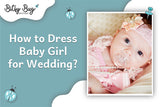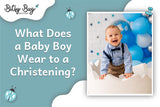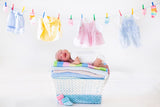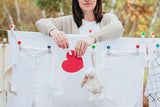How Many Layers Should a Newborn Wear?
If you’re a first-time parent, deciding how to clothe your newborn might be confusing. Since your little one’s comfort is the top priority, numerous things must be considered. So, how many layers should a newborn wear?
We want to save you both time and worries and give you all the needed information in one place. You can learn about the different clothing options, sizes, and practices every new parent should know.
Continue reading to discover all you need to know about newborn clothing and keeping your baby safe and comfortable!

Source: shutterstock.com / Photo Contributor: Elizaveta Shishova
Choosing the Right Clothing and Dressing Your Newborn
Before you decide how to dress your little one, you first need to get the right clothing for them. There are two things to remember during this process: the clothing sizes and the materials they’re made of.
Clothing materials
When doing baby shopping, choose clothing that’s made of natural materials and is easy to put on. Regardless of looks, choose ones that are comfortable for your baby and easy to take care of. You should also pick clothing labeled as a low fire hazard, especially on rompers and jumpsuits.
Some suitable clothing fabrics fit for a newborn are the following:
- Cotton
- Wool
- Linen
- Bamboo
- Gauze
- Footer jersey
- Interlock
- Silk
- Muslin
- Sateen.
Clothing sizes for newborns
Even though numerous chic pieces exist, you need to find the right clothing size for your newborn. However, keep in mind that babies grow fast.
So, don’t go on a shopping spree for clothes they’ll grow out of in just a few months. If you need help finding some stylish options, check out our newborn girls clothing boutique!
That being said, here are the most common labels you’ll find and their weight limits:
- Preemie (P): up to 5 pounds
- Newborn (N or NB): from 5 to 8 pounds
- 0 - 3 months: from 8 to 12 pounds
- 3 - 6 months: from 12 to 16 pounds
- 6 - 9 months: from 16 to 20 pounds
- 9 - 12 months: from 20 to 24 pounds
- 12 - 18 months: from 24 to 28 pounds
- 18 - 24 months: from 28 to 30 pounds
- 2T: from 29 to 32 pounds
- 3T: from 32 to 35 pounds
- 4T: from 35 to 39 pounds
- 5T: from 39 to 43 pounds.
Lastly, when buying newborn clothes, please remember that different brands have different clothing lengths under their labels. That’s why it’s best to check the measurements beforehand or have a piece of clothing to use as a reference to ensure they’ll fit your little one.
Washing newborn clothes
Once you’ve picked the perfect attire for your little boy or girl, you should take good care of it. This includes regular washing of clothes, which isn’t as hard as you think.
You can do so alongside the rest of your laundry without using strong detergents. It’s best to choose the ones with gentle and sensitive labels on them. This will help reduce the risk of irritating your baby’s skin.
Dressing a newborn
Now that you’re well informed on the clothing sizes and fabrics, the next step is getting your baby dressed. We’ll start with a pro tip, do it as fast and calmly as possible to avoid stressing them out. You don’t want your little one to associate dressing up with an unpleasant experience.
Ensure the room has a suitable room temperature and a soft surface on which to put your baby. Furthermore, pay close attention to the clothes to not touch your little one's face since it might make them uncomfortable.
You’re supposed to gently put their arms and hands through the holes to avoid injuring them. Always support your baby’s neck and just follow the same process in reverse to undress them.

How Many Layers Should a Newborn Wear?
The number of clothing layers a newborn should wear highly depends on the weather, season, and setting. Since newborns can regulate their own body temperature, it’s up to you to keep an eye on them. That’s why we’ll go over the clothing choices for both summer and winter, as well as bedtime.
When in doubt, always remember the “plus one” method. Dress your newborn the same way you’ve dressed yourself, then add another layer. It’s a common rule many parents use to ensure their little one is dressed appropriately.
During the summer
Before we begin, please note that the risk of your baby overheating is far more dangerous than them feeling cold. It might lead to dreadful SIDS (sudden infant death syndrome) and numerous other health hazards. So, ensure that your little one is kept cool during the summer period and heat waves.
That said, the first thing you should watch out for is over-dressing your baby. Here’s a simple layering guide for the summer you should follow:
- Avoid too many layers - When the temperature has reached more than 75 °F, a single layer of clothing is enough.
- Use lighter and thinner fabric - If you plan to spend the day outside, make sure the clothing material is breathable.
- Keep them shielded from the sun - Since it’s not recommended to use sunscreen on babies under six months, try to expose them to direct sunlight as little as possible. When you do, make sure their skin is covered in light clothing.
- Use accessories - Protect your little one’s head by covering it with a lightweight hat while also using UV protection sunglasses to protect the eyes.
During the winter
The biggest risk of underdressing a baby for cold winter days is hypothermia. If you notice that they’re quieter than usual, refuse to feed, and have red skin, consult a doctor immediately.
During this season, ensure your little one is wearing as many layers as required. However, don’t overdress them because it’ll only make them uncomfortable, and they may overheat.
Here’s a quick layering guide you can follow:
- Consistent layers - By layering the clothing, the heat is trapped inside, and your baby stays warmer for an extended period. Cotton material works best, so start with a thin onesie and move to a long-sleeved shirt and pants. When going outside, finish off with a jacket or a snowsuit, depending on your area’s weather.
- Blankets - If you’re planning on going outside, always take a blanket with you as a plus one layer. It can be placed in the stroller to keep out the elements while providing extra heat for your baby. However, always remove blankets during a car ride or bedtime to prevent the risk of suffocation.
- Cover up with accessories - Ensure your baby is covered up head-to-toe with mittens, warm socks, boots, and cozy hats.
During bedtime
Since SIDS most likely occurs during bedtime, dressing your baby with the appropriate sleepwear is of utmost importance.
Furthermore, the room your little one is staying in should have an ideal temperature between 68 and 72 °F. Don’t place blankets, comforters, and stuffed animals inside the crib because they’re a choking hazard.
During the hot summer days, your baby can go through the night with only a legless and sleeveless onesie. You can also use a combination of a nappy and singlet to keep them cool and comfortable.
During the cold winter days, it’s best to use a swaddle bag to keep your baby warm. This will also prevent the dreaded Moro reflexes that may wake them up during the night. Once your little one can roll over on their own, you can use a sleeping bag instead.
Beneath the swaddle bag, you can use a long-sleeve shirt or a simple onesie. However, in extremely cold weather, you can use bodysuits and singlets as a bottom layer for extra protection.
TOG-rated clothing
Last but not least, you should also check for TOG-rated clothing for your little one, regardless of the season. This stands for Thermal Overall Grade and is used to determine clothing warmth and insulation. Since babies can’t regulate temperature as adults, this is a smart way to find the best attire for any occasion.
To easily explain it to you, remember that the higher the TOG rating is, the more insulated the clothes are. The same works in reverse, meaning the lighter the clothes are, the lower the rating is.
The lightest TOG-rated sleepwear you can find is a 0.2 sleeping bag, ideal for hot summer nights. On the other hand, the highest-rated sleeping bag is 3.5 and can be used for extremely cold nights.
For room temperatures that range between 71.6 and 75.2 °F, it’s recommended to use a 0.2 TOG-rated layer with a 1.0 TOG-rated swaddle bag. However, if the temperatures go down to 60.8 and 68 °F, use a 1.0 TOG-rated long-sleeve layer and a 2.5 TOG-rated swaddle bag.
Layering Techniques and Options
Layering your baby’s clothes has three simple steps: the top, middle, and bottom layers. Even though there isn’t a strict scheme you should follow, rely on common sense and instinct to choose what suits your little one best. If you notice that they are too hot, remove a layer, while adding another layer should be done if they’re cold.
Regardless of your clothing preference, always ensure the clothing layers fit nicely and aren’t too tight. Plus, the clothes should be breathable and shouldn’t contain any choking hazards.
That being said, here are some clothing ideas for the three layers.
Bottom layer
Since the bottom layer is the base, it’s best to use light-fabric clothing, such as cotton singlets and onesies. This layer might help reduce skin irritation and keep the baby comfortable without overheating.
Furthermore, since it’s closest to the skin, it’s used as protection from irritative materials such as snaps and zippers.
Middle layer
Choosing the second layer highly depends on the weather. Here, you can use leggings, rompers, and bodysuits if you’ve chosen a singlet as the bottom layer. Another option is using cardigans, which go best with onesies underneath.
Top layer
The last layer should protect your little one from the elements if you’re going outside. That means choosing warm mittens, boots, and beanies during the wintertime and UV protection sunglasses for summer.
Additionally, the top layer includes knitwear, jackets, and coats, which protect your baby from wind gusts and rain.
Source: shutterstock.com / Photo Contributor: Netrun78
How to Know If Your Newborn Is Warm or Cold
Regardless of the season, you can always check if your little one is hot or cold by doing a simple touch test. However, there are several things to keep in mind during it.
First off, don’t rely on feeling their hands or feet because they are naturally colder than the rest of the body. That’s why it’s best to touch the belly or behind the neck, where it’s easiest to check the core temperature.
Secondly, the ideal temperature is when your baby’s skin feels lukewarm on your touch. If you notice drops of sweat, you should remove one layer of the clothing. On the other hand, if the skin feels a bit chilly, then it’s best to add another layer.
Lastly, make sure to do the test frequently if you notice your little one is feeling restless and cranky.
Conclusion
How many layers should a newborn wear? Choosing the right layering options for your little one is of utmost importance. It might reduce the risks of weather-related health issues, including SIDS and hypothermia. That’s why you should always check your baby’s temperature, choose the appropriate attire for the weather, and always remember the “plus one” layering rule.
Now that we’ve covered all the essentials, including clothing sizes, fabric, and layering techniques, you’re ready to take on any weather.
We hope this article has helped you and that you’ll find the best clothing options. Don’t forget to give your little ones some well-deserved cuddles and a spot-on style!






